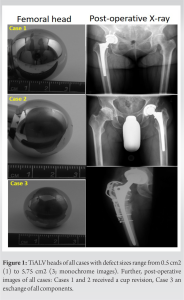Titanium nitride-coated titanium alloy heads contributed to early failure of THA due to osteolysis and implant loosening.
Dr. Nils Wirries, Department of Joint Replacement, Diakovere Annastift Hannover, Hannover, Germany. E-mail: nils.wirries@diakovere.de
Introduction: We present the case studies of three patients requiring revision for premature failure of total hip arthroplasty (THA).
Case Report: All patients received titanium nitride (TiN)-coated heads made of titanium alloy TiALV as part of their index total hip replacements. At the time of revision surgery, intraoperative findings included partial or complete delamination of the TiN head coating and wear/deformation of the TiALV heads.
Conclusion: In addition to PE wear as a known mechanism for THA failure, titanium wear appears to play a major role in contributing to early THA failure and acceleration of PE wear. As a result, the choice of TiN-coated TiALV heads for use in THA should be approached with caution. It is thought that manufacturers of hip implants are aware of this potential problem. However, in a global community, this paper simply aims to bring this knowledge to general attention, while the manufacture of the presented heads does not exist anymore.
Keywords: Total hip arthroplasty, wear, titanium head, revision.
Total hip arthroplasty (THA) is an operation with documented excellent long-term survivorship combined with equally good patient outcomes and significant improvements in quality of life [1,2]. History, however, is also littered with failures in THA related to the quest for improvement in prosthetic longevity. In a simulator study by Gutmanas and Gotman, titanium nitride (TiN)-coated heads showed minimized wear rates without a hint of delamination after 4×106 cycles [3]. TiN-coated heads are made of titanium alloy TiALV. It is a chemical composition made of titanium, 6% aluminum, and 4% vanadium and is commonly used in orthopedic implants. In the meanwhile, these TiN-coated heads were mainly no longer produced. Successful THA requires excellent surgical technique in combination with a choice of implants that have favorable long-term survivorship. We present the case studies of three patients who had premature failure of THA from osteolysis caused by aseptic loosening and periprosthetic fracture. TiN-coated heads made of titanium alloy were implanted in all three patients. In line with significant PE wear, clinical findings and features of this titanium alloy implant failure are presented, and possible mechanisms for failure are discussed.
Three patients (Fig. 1) initially received an uncemented titanium stem, a titanium threaded cup with an inclination between 40 and 45°, standard ultra-high-molecular-weight-polyethylene inlays, and a 28 (n = 1) or 32 mm (n = 2) TiN-coated head. In all cases, the acetabular component was to be revised due to definite aseptic loosening (Pinnacle® cup: Sector II n = 2, Multihole n = 1). Marathon® liners and Articul/eze® (CoCr; Arge) heads were used in all instances for revision, expect for Case 3.
Case 1 (female, 76 years) has had minimal osteolysis around the proximal stem with no loosening, and thus, the femoral implant was retained. The initial diagnosis for THA was primary osteoarthritis. The revision-free interval was 9.5 years (07/00–01/10). Case 2 (male, 56 years) has had femoral osteolysis Type II (Paprosky) of the well-fixed stem 10.9 years (06/01–05/12) after THA due mild dysplasia and was treated with bone grafting of the proximal defects (15 cm3).
Case 3 (male, 47 years) has had more extensive osteolysis affecting the ischium and pubis (type IIIa) with severe metallosis and sander marks on the head’s surface. Metal wear was seen in the histologic samples. Extensive bone grafting of the defects in the ischium (12 cm3) and pubis (8 cm3) was necessary. The stem was clinically loose at surgery and was revised using a solution stem (DePuy) through an extended trochanteric osteotomy, plus a trochanteric grip plate due to refixation of periprosthetic trochanteric fracture (Trofix®, Zimmer, Fig. 1b). The primary surgery was 10.0 years ago (01/02–12/11). Retrieved implants demonstrated significant volumetric wear of the liner (up to 2.84 cm3) with either partial or complete loss of the TiN coating and volumetric wear of the TiALV-heads. In all three cases, the TiN coating was delaminated to varying but significant extents. No backside wear or liner damage was noted. Measurements were done by three independent blinded assessors and averaged. An electronic digital caliper (digiMax, Swiss Precision Instruments, Inc.,) was used. The damaged femoral head coating ranged 0.5 cm2 (elderly patient) to 5.75 cm2 (two younger patients, Fig. 1). The two younger patients also had a defect of the TiALV head itself. All defects were palpable. The head diameter was reduced by 0.19 mm (32 mm head) and 0.18 mm (28 mm head). Histologically, a range of mild to severe metallosis was found in three cases in addition to wear-induced synovitis [4, 5]. All patients suffered from mainly load depending hip pain without neurological symptoms.
Osteolysis and component loosening following total hip replacement remains to be a major clinical issue. Example of increased volumetric wear and early failure has resulted from attempts to introduce new technologies aimed to decrease wear and improve longevity. Our study documents early prosthetic loosening related to the use of TiN-coated TiALV heads. We could not identify other failure-related factors. All cases received their primary THA due to primary osteoarthritis or mild dysplasia of the hip. Thus, severe and complex deformity was not present in the primary setting that might have influenced the time to loosening. In all settings, no septic condition was present. A probably approach-related impact on the implant loosing and dislocations was observed with cemented stem components in the Swedish Hip Arthroplasty Register [6]. However, all the presented cases were treated with cementless stems. Although prosthetic wear is to be expected, especially in active and high demand patients [7], failure of implants around 10 years should be considered as early failure. Moreover, massive osteolysis and titanium-related metallosis may lead to major problems technical difficulties during revision procedures. Bone grafting and complete removal of PE and titanium debris are required in these instances. Titanium alloy particles have been implicated as a cause of significant periprosthetic reactions and osteolysis leading to premature prosthetic failure and early revision [8-12]. Recent laboratory studies support a major role of titanium wear particles in implant failure, and this is born out clinically in the cases we have seen. Cytological examination of the areas surrounding failed implants has indicated an increase in the bone-resorption-inducing cytokine, interleukin 1β (IL-1β), due to activation of the NALP3 inflammasome, which leads to increased IL-1β secretion and IL-1-associated signaling, including neutrophil recruitment [13]. Further, titanium wear may cause neurological symptoms due to oxidative stress reactions and mitochondrial process changes (in vitro) [14]. However, within our case series, non-neurological disorder could be observed.
TiN-coated TiALV heads contributed to early failure of THA due to osteolysis and implant loosening. As recent studies demonstrate, it is not only polyethylene debris but also Ti-particles that can induce or accelerate osteolysis. The wear of TiN-coated TiALV heads and the resulting massive osteolysis as seen in these three cases is of significant concern. Further, titanium wear may cause neurological symptoms due to oxidative stress reactions and mitochondrial process changes (in vitro).
We recommend caution in the choice of titanium-coated femoral heads as these have caused significant clinical problems in our experience. Although these TiN-coated heads that were used in the presented failure cases are no longer available, it seems important to bring the knowledge and possible mechanisms of failure to global attention both for developers of hip implants and users.
References
- 1.Mariconda M, Galasso O, Costa GG, Recano P, Cerbasi S. Quality of life and functionality after total hip arthroplasty: A long-term follow-up study. BMC Musculoskelet Disord 2011;12:222. [Google Scholar]
- 2.Knight SR, Aujla R, Biswas SP. Total hip arthroplasty - over 100 years of operative history. Orthop Rev (Pavia) 2011;3:e16. [Google Scholar]
- 3.Gutmanas EY, Gotman I. PIRAC Ti nitride coated Ti-6AI-4V head against UHMWPE acetabular cup-hip wear simulator study. J Mater Sci Mater Med 2004;15:327-30. [Google Scholar]
- 4.Krenn V, Morawietz L, Haupl T, Neidel J, Petersen I, König A. Grading of chronic synovitis--a histopathological grading system for molecular and diagnostic pathology. Pathol Res Pract 2002;198:317-25. [Google Scholar]
- 5.Krenn V, Otto M, Morawietz L, Hopf T, Jakobs M, Klauser W, et al. Histopathologic diagnostics in endoprosthetics: Periprosthetic neosynovialitis, hypersensitivity reaction, and arthrofibrosis. Orthopade 2009;38:520-30. [Google Scholar]
- 6.Lindgren V, Garellick G, Karrholm J, Wretenberg P. The type of surgical approach influences the risk of revision in total hip arthroplasty: A study from the Swedish Hip arthroplasty register of 90,662 total hipreplacements with 3 different cemented prostheses. Acta Orthop 2012;83:559-65. [Google Scholar]
- 7.Wangen H, Lereim P, Holm I, Gunderson R, Reikerås O. Hip arthroplasty in patients younger than 30 years: Excellent ten to 16-year follow-up results with a HA-coated stem. Int Orthop 2008;32:203-8. [Google Scholar]
- 8.Baumann B, Seufert J, Rolf O, Jakob F, Goebel S, Eulert J, et al. Upregulation of LITAF mRNA expression upon exposure to TiAlV and polyethylene wear particles in THP-1 macrophages. Biomed Tech (Berl) 2007;52:200-7. [Google Scholar]
- 9.Agins HJ, Alcock NW, Bansal M, Salvati EA, Wilson PD Jr., Pellicci PM, et al. Metallic wear in failed titanium-alloy total hip replacements. A histological and quantitative analysis. J Bone Joint Surg Am 1988;70:347-56. [Google Scholar]
- 10.Jakobsen SS, Larsen A, Stoltenberg M, Bruun JM, Soballe K. Effects of as-cast and wrought cobalt-chrome-molybdenum and titanium-aluminium-vanadium alloys on cytokine gene expression and protein secretion in J774A.1 macrophages. Eur Cell Mater 2007;14:45-54; discussion 54-5. [Google Scholar]
- 11.Manlapaz M, Maloney WJ, Smith RL. In vitro activation of human fibroblasts by retrieved titanium alloy wear debris. J Orthop Res 1996;14:465-72. [Google Scholar]
- 12.Mostardi RA, Kovacik MW, Ramsier RD, Bender ET, Finefrock JM, Bear TF, et al. A comparison of the effects of prosthetic and commercially pure metals on retrieved human fibroblasts: the role of surface elemental composition. Acta Biomater 2010;6:702-7. [Google Scholar]
- 13.St Pierre CA, Chan M, Iwakura Y, Ayers DC, Kurt-Jones EA, Finberg RW. Periprosthetic osteolysis: Characterizing the innate immune response to titanium wear-particles. J Orthop Res 2010;28:1418-24. [Google Scholar]
- 14.Huerta-Garcia E, Perez-Arizti JA, Marquez-Ramirez SG, Delgado-Buenrostro NL, Chirino YI, Iglesias GG, et al. Titanium dioxide nanoparticles induce strong oxidative stress and mitochondrial damage in glial cells. Free Radic Biol Med 2014;73:84-94. [Google Scholar]









